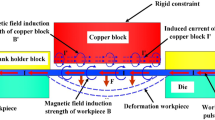Abstract
Electromagnetic forming has good prospects in light alloy forming. In the EMF process, intense current causes considerable temperature rise in the driving coil, which may reduce the service life of the driving coil. The cooling circuit method is one of the ways to solve this problem by using mutual inductance between the driving coil and the cooling coil to transfer Joule heat. This paper derives the dependence of cooling efficiency on circuit parameters. Then with a validated finite element model, the influence of coupling coefficient, discharge frequency, coil turns, and impedance angle on EMF process are analyzed in detail. The simulation results are in good agreement with the theoretical prediction. In addition, the influence of the switch-on time on the cooling effect and deformation is analyzed at two different frequencies. With the optimized parameter and switch-on time, the Joule heat in the driving coil during the EMF process has a considerable decrease especially at a higher frequency.



















Similar content being viewed by others
Data availability
The authors confirm that the data supporting the findings of this study are available within the article.
References
Huang L, Zhang J, Zou J, Zhou Y, Qiu L (2019) Effect of equivalent radius of drive coil on forming depth in electromagnetic sheet free bulging. Int J Appl Electromagn Mech 61(3):377–389. https://doi.org/10.3233/Jae-190009
Huang L, Ding Z, Zhou Y, Zeng J, Zou J (2020) Effect of the radial dimension of the driver sheet on the electromagnetic driven forming. IEEE Access 8:133503–133513. https://doi.org/10.1109/Access.2020.3010000
Seth M, Vohnout V, Daehn G (2005) Formability of steel sheet in high velocity impact. J Mater Process Technol 168(3):390–400. https://doi.org/10.1016/j.jmatprotec.2004.08.032
Cao Q, Du L, Li Z, Lai Z, Li Z, Chen M, Li X, Xu S, Chen Q, Han X, Li L (2019) Investigation of the Lorentz-force-driven sheet metal stamping process for cylindrical cup forming. J Mater Process Technol 271:532–541. https://doi.org/10.1016/j.jmatprotec.2019.03.002
Gies S, Tekkaya A (2017) Effect of workpiece deformation on joule heat losses in electromagnetic forming coils. Procedia Eng 207:341–346. https://doi.org/10.1016/j.proeng.2017.10.785
Gayakwad D, Dargar M, Sharma P, Purohit R, Rana R (2014) A review on electromagnetic forming process. Procedia Mater Sci 6:520–527. https://doi.org/10.1016/j.mspro.2014.07.066
Kuo C, You J, Hwang S (2011) Temperature effect on electromagnetic forming process by finite element analysis. Int J Appl Electromagn Mech 35(1):25–37. https://doi.org/10.3233/jae-2011-1319
Werdelmann P, Rosendahl J, Peier D, Kulig S (2008) Assessing the effective energy for magnetic forming processes by means of measurements and numerical calculation. In: Proceedings of the 3rd International Conference on High Speed Forming, Dortmund, Germany, pp 11–12. https://doi.org/10.17877/DE290R-8670
Golovashchenko S (2007) Material formability and coil design in electromagnetic forming. J Mater Eng Perform 16(3):314–320. https://doi.org/10.1007/s11665-007-9058-7
Qiu L, Han X, Peng T, Ding H, Xiong Q, Zhou Z, Jiang C, Lv Y, Li L (2012) Design and experiments of a high field electromagnetic forming system. IEEE Trans Appl Supercond 22(3):3700504–3700504. https://doi.org/10.1109/tasc.2011.2178223
Gies S, Löbbe C, Weddeling C, Tekkaya A (2014) Thermal loads of working coils in electromagnetic sheet metal forming. J Mater Process Technol 214(11):2553–2565. https://doi.org/10.1016/j.jmatprotec.2014.05.005
Golovashchenko S, Bessonov N, Davies R (2006) Design and testing of coils for pulsed electromagnetic forming. In: Proceedings of the 2nd International Conference on High Speed Forming. https://doi.org/10.17877/DE290R-12928
Oliveira D, Worswick M, Finn M, Newman D (2005) Electromagnetic forming of aluminum alloy sheet: free-form and cavity fill experiments and model. J Mater Process Technol 170(1–2):350–362. https://doi.org/10.1016/j.jmatprotec.2005.04.118
Cao Q, Han X, Lai Z, Xiong Q, Zhang X, Chen Q, Xiao H, Li L (2015) Analysis and reduction of coil temperature rise in electromagnetic forming. J Mater Process Technol 225:185–194. https://doi.org/10.1016/j.jmatprotec.2015.02.006
Qiu L, Wang C, Abu-Siada A, Xiong Q, Zhang W, Wang B, Yi N, Li Y, Cao Q (2020) Coil temperature rise and workpiece forming efficiency of electromagnetic forming based on half-wave current method. IEEE Access 8:9371–9379. https://doi.org/10.1109/access.2020.2965254
Qiu L, Deng K, Li Y, Tian X, Xiong Q, Chang P, Su P, Huang L (2020) Analysis of coil temperature rise in electromagnetic forming with coupled cooling method. Int J Appl Electromagn Mech 63(1):45–58. https://doi.org/10.3233/jae-190062
Psyk V, Risch D, Kinsey B, Tekkaya A, Kleiner M (2011) Electromagnetic forming—a review. J Mater Process Technol 211(5):787–829. https://doi.org/10.1016/j.jmatprotec.2010.12.012
Qiu L, Wang B, Abu-Siada A, Xiong Q, Zhang W, Ge W, Liu C, Jiang L, Wang C (2020) Research on forming efficiency in double-sheet electromagnetic forming process. IEEE Access 8:19248–19255. https://doi.org/10.1109/access.2020.2968049
Cui X, Mo J, Li J, Huang L, Zhu Y, Li Z, Zhong K (2013) Effect of second current pulse and different algorithms on simulation accuracy for electromagnetic sheet forming. Int J Adv Manuf Technol 68(5–8):1137–1146. https://doi.org/10.1007/s00170-013-4906-0
Acknowledgements
Lantao Huang is a member of the IEEE.
Funding
This work was supported in part by the National Natural Science Foundation of China 51607152 and the Presidential Fund of Xiamen University 20720180079.
Author information
Authors and Affiliations
Contributions
Lantao Huang, and Quqin Sun were responsible for deriving formulas. Zinan Ding, Jin Zeng, and Yihan Zhou were responsible for simulation. Lantao Huang, Zinan Ding, and Quqin Sun were involved in the discussion and significantly contributed to making the final draft of the article. All the authors read and approved the final manuscript.
Corresponding author
Ethics declarations
Ethical approval
Not applicable.
Consent to participate
Not applicable.
Consent to publish
Not applicable.
Competing interests
The authors declare no competing interests.
Additional information
Publisher’s note
Springer Nature remains neutral with regard to jurisdictional claims in published maps and institutional affiliations.
Rights and permissions
About this article
Cite this article
Huang, L., Ding, Z., Zeng, J. et al. Optimization of the coupled cooling circuit in electromagnetic forming with finite element analysis. Int J Adv Manuf Technol 116, 2211–2221 (2021). https://doi.org/10.1007/s00170-021-07525-1
Received:
Accepted:
Published:
Issue Date:
DOI: https://doi.org/10.1007/s00170-021-07525-1



